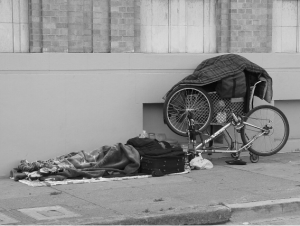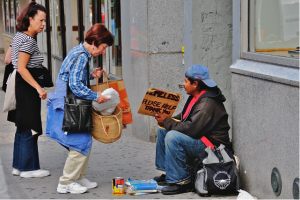5 Homelessness: What is the Solution?
Andie MacPherson and Bryn Powell
Olympic Games and Homelessness
The Olympic Games are an international sports festival typically held every four years with the main goals to develop better humans and to bring world peace (Tokyo Organising Committee of the Olympic and Paralympic Games, 2015). Viewers across the globe are shown picturesque views of mountains, newly built arenas, and stadiums in the host cities and smiling spectators who have travelled from all over the world to come watch the games. What viewers are not shown, however, is the impact of the Olympic Games on homelessness in host cities.

As part of Vancouver’s Olympic bid in 2010, the partners promised to create an affordable housing legacy, protect rental housing, and make sure homelessness doesn’t increase because of the Games. (Poverty Olympics, n.d). The problem with Olympic bids are that there are no policies to ensure host cities follow through with these promises.
Vancouver initially planned on the Olympic Village becoming two-thirds social housing once the Games were completed (Currie, 2020). They have now halved that amount of social housing, providing only 125 units (CBC News, 2010). Single room occupancy hotels (SROs), a last resort for people before becoming homeless, were converted into condos to meet the demand of visitors, decreasing affordable and accessible housing options (Delisle, 2010).
After Vancouver failed in providing more adequate housing, to protect the image of the city, the Assistance Shelter Act, which is also known in the community as the “Olympic Kidnapping Act,” was put in place. This law permitted police to remove homeless people from the streets and dump them in shelters during extreme weather alerts. One shocking example was when the city set up an information centre on the Downtown Eastside, where they could meet journalists prior to the journalists witnessing the severity of the homelessness crisis in the area. The information centre explained to journalists how Vancouver successfully tackled homelessness during the Olympics. They boasted about how they are building social housing on 14 sites, which was of course delayed and not ready in time for the Games. Icing on the cake: the information centre cost $150,000 (Delisle, 2010). Could we think of a better way to spend that money? Build social housing, reinvest in the community? We are just thinking off the top of our heads here.
The Olympic Games are far from perfect and can provide a useful platform to address social inequities occurring in our society. We love watching the Games and feeling united with our country, but we must think of its detrimental effects on homelessness and other inequities in our society.
Prevalence in Canada
Homelessness in Canada is incredibly prevalent. According to a recent study approximately 235,000 Canadians experience homelessness in a year, and 35,000 Canadians experience homelessness on any given night (Rech, 2019). In 2014, approximately 2.3 million Canadians reported that at some point in their life, they had to temporarily live with family, friends, or in their car because they had no place to live.
Homelessness is disproportionately affecting people with disabilities, the LGBTQ+ community, Indigenous peoples, and racialized communities, especially youth. Out of the 7.2 million Canadians aged 15+ with a disability, 13% also reported having experienced homelessness, compared with 6% of Canadians without a disability (Rodrigue, 2016). Additionally, Indigenous peoples represent 4.3% of Canada’s population but account for 28-34% of the homeless shelter population (Rech, 2019). Youth aged 13-24 made up 18.7% of homeless people in Canada. Of this percentage, 29.5% identified as LGBTQ, 30.6% Indigenous, and 28.2% were from a racialized group (Rech, 2019).
So why are people in these specific demographic groups disproportionately affected by homelessness?
Studies suggest that LGBTQ+ youth are more likely to be homeless due to rejection from their families (Poverty Hub: A Canadian Poverty Institute Initiative, n.d). The colonization of Indigenous peoples has led to emotional trauma that has resulted in increased substance use, violence, and family problems, which are all contributing factors to homelessness. Other systemic issues have resulted in landlord discrimination, and low levels of education and high unemployment (Indigenous Peoples, n.d). People with disabilities are also discriminated against and lack the same employment options as people without disabilities, resulting in higher levels of poverty (People with Disabilities, n.d). It’s clear that these marginalized groups are being disproportionately affected due to systemic barriers that further limit their access to affordable housing.
Systemic Barriers
“Just get a job” is a common phrase used as a simple solution to homelessness in Canada. However, homelessness is deeply rooted in historic systemic barriers, mainly a lack of accessible housing.
The process of getting a job isn’t so simple, especially when you don’t have a stable place to call home. If applicants have access to a printer, they can hand in a resume. After you hand in a resume, employers schedule an interview: how does one get in contact with the employer if they don’t have a phone? Now let us say they figure out the time and place of the interview, how are they going to appear physically at the interview? They may not have access to water for a shower or access to laundry for clean clothes. Even if they do get the job, most companies require a bank account to pay an employee’s wage, requiring a permanent address. See how many barriers there are between people without homes and just “getting a job”? These barriers are all rooted in a lack of accessible housing.
In Canada, the increase in homelessness can be linked back to when the federal government cut funding in the 1980s. Since then, new social housing units decreased from 20,450 new units annually in 1982 to building only 4,393 units in 2006 (Gaetz et al., 2014). While Canada’s population has increased by nearly 30%, investment in housing has decreased by over 46% (Gaetz et al., 2014). Another contributing factor is a lack of rental property housing. Most low-income families cannot afford to provide a down payment to purchase a house and, therefore, rely on affordable rental properties. A recent study demonstrates that approximately 200,000 rental units are destroyed annually, further limiting the options of affordable housing (National Coalition for the Homeless, 2009). The combination of increasing rental prices and decreasing availability of rental properties has contributed to a homelessness crisis in Canada. Another systemic barrier that leads to homelessness, is a lack of income, such as unemployment and limited income opportunities. A low income could be the result of factors out of an individual’s control, for instance, low education levels or disabilities that impact possible career choices. Additionally, a lack of supportive programming and services for people with mental illness, and substance abuse can contribute to the homelessness crisis in Canada (Buckland et al., 2001). The cumulative effect of the systemic barriers we have identified has allowed for a continuous cycle of individuals becoming homeless.
The Truth Behind Homelessness

What if we told you that everything you thought you knew about homelessness is wrong? Individuals experiencing homelessness endure every kind of stereotype imaginable, most of which emphasize the assumption that they’ve ended up on the street through fault of their own. Many people believe that health issues, such as addiction or mental illness are the root of the problem. In fact, these health issues are often the result of homelessness, as opposed to the cause, as alcohol or drugs are commonly used as a coping mechanism to help people deal with their living situations. In addition, many unsheltered people are bombarded with comments such as, “you’re so lazy” or “just get a job”, but people who are more well-off fail to realize it is not a lack of work ethic or a moral failing, it’s a systemic problem. In fact, many people without homes work but don’t earn enough to make a living, therefore they work during the day and stay at a shelter for the night (Buchner, 2019). There is not much you can do without a stable home; individuals are already put at a massive disadvantage when they don’t have a place that they can call their own. After finding a stable place to live, mental health and other personal issues suddenly become increasingly more manageable (Buchner, 2019). It all comes down to this: homelessness has less to do with personal failings than it does with policy failings. Historically, there was never a problem of chronic homelessness, but today, our shelter system is being stretched too thin. The truth is that housing, and the various supports that help people secure it, have become less, and less accessible over the years. Cuts to affordable housing and a failure to respond to a country that is constantly changing have left people in vulnerable situations (Buchner, 2019). The real issue is that policies haven’t kept up with these trends fast enough to protect the endangered populations affected by them.
Fixing the Problem

So how do we fix this problem? The answer to this problem may lie in Alberta, specifically a southeast city called Medicine Hat. The city adopted a new approach in 2009 to solve the homeless crisis. To most people’s surprise, the city had completely ended chronic homelessness by 2015 (Buchner, 2019). The approach seems simple: when individuals experiencing homelessness are supplied housing, given a role in finding that housing, and offered support for education, mental health, or substance abuse, they can successfully remain housed. A study found that more than 80% of individuals experiencing homelessness were still housed a year later after receiving housing support based on this approach (Goerging et al., 2014). Giving unsheltered people an active role in the search for housing, as well as supportive programs for secondary health issues, is a successful intervention in the search for the end to homelessness.
Advocacy and activism are also important. The Red Tent Campaign, which set up red tents across Canada, stemmed from protests during the 2010 Vancouver Olympics Games. This campaign was started to highlight Canada’s homelessness crisis and to call for a national housing program. At the time 300,000 Canadians were homeless (Monsebraaten, 2010). Earlier protests in Vancouver had been met with backlash as condo residents next door put up a sign that read “Build resumes, not tents” (Pablo, 2010). This is a clear example of a lack of education and a lack of respect for people who are homeless. The story of the Vancouver Olympics makes evident that there is a need for advocacy for those most affected by these events and for policy change – like a national housing program.
References
Buchner, J. (2019, December 16). Everything you thought you knew about homelessness is wrong. Local Love. https://locallove.ca/issues/everything-you-thought-you-knew-about-homelessness-is-wrong/#.X62bRVNKhTY
Buckland, L., Jackson, A., Roberts, P., Smith, P., & Marland, R. (2001). Structural and Systemic Factors Contributing to Homelessness in Canada: An Analysis of Research Gaps.
CBC News. (2010, April 23). Vancouver cuts Olympic Village social housing. CBC. https://www.cbc.ca/news/canada/british-columbia/vancouver-cuts-olympic-village-social-housing-1.882070
Currie, E. (2020, February 14). Did the 2010 Olympics contribute to Vancouver’s housing crisis?. CTV. https://bc.ctvnews.ca/did-the-2010-olympics-contribute-to-vancouver-s-housing-crisis-1.4809537#:~:text=%E2%80%9CEarly%20on%2C%20the%20Olympic%20Village,land%2C’%E2%80%9D%20he%20says.
Delisle, R. (2010, March 10). Counting the Vancouver 2010 Olympics’ broken promises. This. https://this.org/2010/03/10/olympics-broken-promises-homelessness-vancouver/
Gaetz, S., Gulliver, T., & Richter, T. (2014). The state of homelessness in Canada 2014. Canadian Homelessness Research Network. https://www.homelesshub.ca/SOHC2014
Goering, P., Veldhulzen, S., Watson, A., Adair, C., Kopp, B., Latimer, E., . . . Aubry, T. (2014). National Final Report: Cross-Site At Home/Chez Soi Project (pp. 14-16, Rep.). Calgary: Mental Health Commission of Canada.
Indigenous Peoples. (n.d). Homeless Hub. https://www.homelesshub.ca/about-homelessness/population-specific/indigenous-peoples#:~:text=Homelessness%20amongst%20Indigenous%20Peoples%20can,of%20Indigenous%20land%20and%20populations.
Monsebraaten, L. (2010, October 18). Red tent campaign calls for housing strategy. The Star. https://www.thestar.com/news/canada/2010/10/18/red_tent_campaign_calls_for_housing_strategy.html
National Coalition for the Homelessness. (2009, July). Why are people homeless?. National Coalition for the Homelessness. https://www.nationalhomeless.org/factsheets/why.html#:~:text=About%20200%2C000%20rental%20housing%20units,Income%20Housing%20Coalition%2C%202005
Pablo, C. (2010, February 17). Downtown Eastside tent city highlights lack of housing in Vancouver. The Georgia Straight. https://www.straight.com/article-290445/vancouver/housing-still-lacking-city
People with Disabilities. (n.d). Homeless Hub. https://www.homelesshub.ca/solutions/priority-populations/people-disabilities
LGBTQ. (n.d). Homeless Hub. https://www.homelesshub.ca/povertyhub/diversity/LGBTQ
Broken Promises. (n.d.). Poverty Olympics. http://povertyolympics.ca/?page_id=4
Rech, N. (2019, July 9). Homelessness in Canada. The Canadian Encyclopedia. https://thecanadianencyclopedia.ca/en/article/homelessness-in-canada
Rodrigue, S. (2016, November 15). Hidden Homeless in Canada. Statistics Canada. https://www150.statcan.gc.ca/n1/pub/75-006-x/2016001/article/14678-eng.htm
About the Olympic Games. (n.d.). Tokyo 2020. https://tokyo2020.org/en/games/olympic-games-about/#:~:text=The%20Olympic%20Games%20is%20a,and%20world%20peace%20through%20sports.

